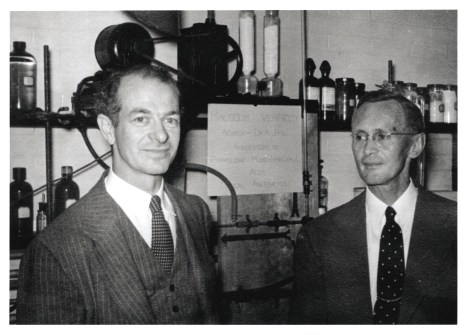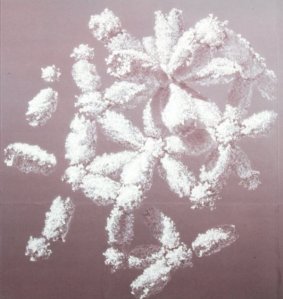
Image of the Crellin Laboratory taken around the time of its dedication in 1938.
Towards the end of the summer of 1937, Linus Pauling was confident that the Rockefeller Foundation would award a $300,000 grant to both the Division of Chemistry and Chemical Engineering and the Division of Biology at the California Institute of Technology. Indeed, so confident was Pauling that he requested permission from the Caltech Executive Council to leverage the forthcoming funds and begin spending immediately on a combined recording microphotometer, densitometer, and comparator. Once permission had been granted, Pauling secured the services of Fred Henson, who had constructed an apparatus of this sort for J. W. McBain of Stanford. Henson agreed to deliver a similar device to Caltech within one year for $2,600 — a thousand dollars less than he normally charged. Pauling also used $850 from funding provided by the British hydrocarbon company M. W. Kellogg to purchase a different instrument.
These new purchases would be put to use in the nearly finished Crellin Laboratory, and staffing and outfitting the facility was an issue of pressing concern. While Pauling and Rockefeller administrator Warren Weaver were still holding out a sliver of hope that the Scottish chemist Alexander Todd would relocate to Pasadena to head the new laboratory, another Rockefeller-funded hire, Carl Niemann, was in the process of equipping and stocking the facility. As he moved forward with this work, Niemann put forth the suggestion that a “central analytical laboratory for the entire department,” with one person in charge, be identified to save space and minimize redundant equipment purchases. This shared laboratory would cost about $3,500 to $4,500 to outfit, whereas the cost of consumables at comparable four-person laboratories ranged from $1,200 to $8,000. Niemann planned to finalize these arrangements in the fall before leaving for a year-long trip to Europe.
In December 1937, after years of negotiation and coordination, Pauling’s feelings of confidence were validated when the Rockefeller Foundation’s Board of Trustees finally approved the Caltech biochemistry grant. Funds would be dispersed beginning in July 1938, and would coincide with the Chemistry division’s move into Crellin. The proposed budget for the first year of the grant largely followed Warren Weaver’s earlier suggestion of $60,000, though Pauling made a successful push for an extra $10,000 to augment organic chemistry research salaries and equipment. When Alexander Todd, following a May visit, ultimately decided not to come to Caltech, the spending plan returned to $60,000. The following year, Pauling shifted the extra $10,000 allocation into hiring researchers and assistants while also purchasing more equipment.
In February 1938, as plans began to settle, Pauling wrote a letter of thanks to Weaver, expressing his gratitude to the Rockefeller board for approving their grant application, and to Weaver for his ideas on how best to develop organic chemistry at Caltech, an initiative that was going smoothly. Pauling likewise acknowledged his personal indebtedness to Weaver for helping to fund and secure his own research. Colleagues of significant consequence including Robert Corey and Max Delbruck had come aboard under the grant and were doing good work. Pauling himself was also warming up to Weaver’s vision, writing, “I am getting more interested in biological problems every day, and am anxious to see our new program in effect.”

Pauling and Arthur Hill at Yale University, 1947
Amidst all of this progress, a test of Pauling’s commitment to his new position as chair arose less than a year after his official appointment. In March 1938, Arthur Hill, a chemist at Yale University, offered Pauling a Sterling Professorship, the highest professorial rank awarded by the university. Pauling’s proposed salary at Yale would be $10,000 and he would also benefit from the services of a private assistant.
Pauling thought hard about the offer, at first replying that he would need a week to think about it. That week stretched into five, and ended with Pauling’s decision to stay at Caltech. In turning down the opportunity, Pauling explained to Hill that he had only recently become chair of a growing division, a circumstance that not only promised to open up new areas of research for himself, but presented him with “an attractive opportunity for contributing effectively to science” by shaping the development of the division. Hill was disappointed, but admitted that the research capacity available at Yale could not compete with what had been built at Caltech.
Feeling more established in his new position as chair, Pauling wrote to Caltech Executive Council chair Robert Milliken in April 1938 that “The outlook for the Division during the next few years is very attractive, especially for the field of the organic chemistry of biological substances.” That said, Pauling was looking for further backing from upper administration. Pauling already had a promise in hand from Caltech’s Board of Trustees that $40,000 would be made available as a complement to the Rockefeller funds, but he wanted further reassurance from Millikan that the Institute would continue to support the division’s nascent biochemistry research well into the future. Buoyed by the momentum of recent months, Millikan was glad to offer this assurance.
On May 16, 1938, the Crellin Laboratory was formally dedicated at a ceremony featuring addresses from Pauling and the building’s patron and namesake, Edward Crellin. In his remarks, Crellin told the audience,
It is pleasing to note the physical union of this building with the new unit of the great William G. Kerckhoff Laboratories of the Biological Sciences, thus enabling Dr. Thomas Hunt Morgan and Dr. Linus Pauling and their associates literally to join hands in the search for, if not the elixir of life, a better understanding of vital processes, leading to better health and longer and happier lives.
For his part, Pauling gave a largely impromptu address, noting how he would have to restrict himself as he was used to lecturing for an hour and not giving five minute speeches. Later, once the facility was up and running, Pauling asked Arnold Beckman to write about it for Industrial and Engineering Chemistry, Analytical Edition, the predecessor journal of today’s Analytical Chemistry.
With Crellin dedicated and the Rockefeller grant in effect, Weaver and Pauling continued their brainstorming about who best to head research in the new laboratory. In the summer of 1938, Weaver mentioned to Pauling that Laszlo Zechmeister, a biochemist from Hungary who had developed chromatography methods to separate enzymes, was visiting the United States and suggested that Pauling invite him to Pasadena. Pauling obliged, arranging for Zechmeister to give three lectures on chromatography, carotenoids, and polysaccharides in November.
As it turned out, Pauling was impressed by the quality of Zechmeister’s presentations, and began to think more seriously about hiring him following a weekend trip to Mexico that he and Ava Helen took with Zechmeister and his wife. Pauling’s estimation of Zechmeister rose in particular once he had learned more about the extent to which Zechmeister had managed to produce as a scientist despite working in a poorly equipped Budapest lab. Though Zechmeister departed from Pasadena without a formal job offer, he would soon become an important figure at Caltech’s new research facility.
Filed under: Pauling as Administrator | Tagged: California Institute of Technology, Carl Niemann, Crellin Laboratory, Laszlo Zechmeister, Linus Pauling, Rockefeller Foundation, Warren Weaver | Leave a comment »
































